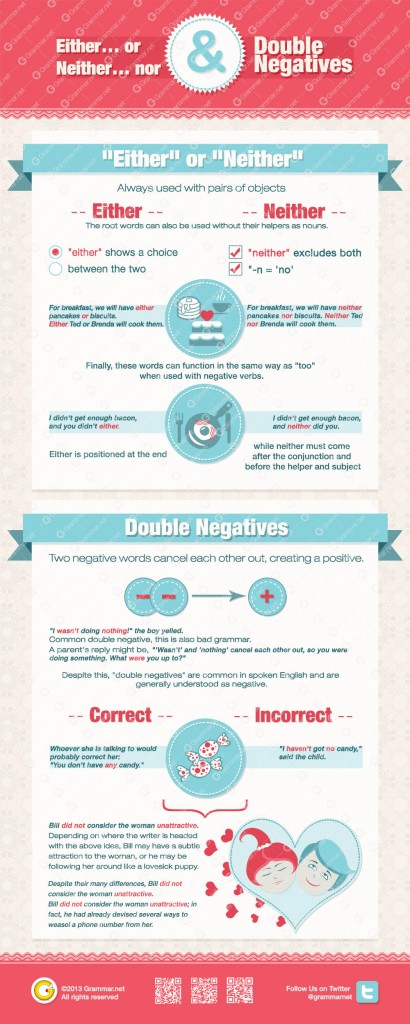“Either or” and “neither nor” can be confusing to those learning English, and “double negatives” can be friends or foes. Help is on the way with a few rules, some handy tips and a convenient infographic.
Click here to download high resolution poster.
“Either” or “Neither”
At the very start, understand that the presence of -n signals a negative. Think “-n equals ‘no’.” Always used with pairs of objects, ideas and so forth, “either” shows a choice between the two, while “neither” excludes both. To couple each word with its correct helper, watch for the -n. Try repeating them out loud several times, as their almost singsong quality can help to cement them into your mind: “either or,” “neither nor”…”either or,” “neither nor.”
For breakfast, we will have either pancakes or biscuits.
Either Ted or Brenda will cook them.
For breakfast, we will have neither pancakes nor biscuits.
Neither Ted nor Brenda will cook them.
In the first pair, there is a choice between the two; in the second pair, both are excluded. The root words can also be used without their helpers as nouns.
I’m starving, so either is fine with me.
Neither can make decent gravy.
Finally, these words can function in the same way as “too” when used with negative verbs. Either is positioned at the end, while neither must come after the conjunction and before the helper and subject.
I didn’t get enough bacon, and you didn’t either.
I didn’t get enough bacon, and neither did you.
Double Negatives
Two negative words cancel each other out, creating a positive. Despite this, “double negatives” are common in spoken English and are generally understood as negative. Before your head explodes, here are some examples of double negatives with explanations.
“I haven’t got no candy,” said the child.
This is incorrect grammar, but anyone speaking with her would assume she has no candy. Whoever she is talking to would probably correct her: “You don’t have any candy.”
“I wasn’t doing nothing!” the boy yelled.
Another common double negative, this is also bad grammar. A parent’s reply might be, “‘Wasn’t’ and ‘nothing’ cancel each other out, so you were doing something. What were you up to?”
Bill did not consider the woman unattractive.
While the first two examples are simply bad grammar, creative use of double negatives can help to paint a picture by calling attention and emphasizing something. Depending on where the writer is headed with the above idea, Bill may have a subtle attraction to the woman, or he may be following her around like a lovesick puppy.
Despite their many differences, Bill did not consider the woman unattractive. (Subtle)
Bill did not consider the woman unattractive; in fact, he had already devised several ways to weasel a phone number from her. (Over the top)
“Neither or either” rules are straightforward, but double negatives can be tricky, considering their widespread use in spoken English. Can you think of a double negative that you hear regularly but know to be incorrect?




![Dashes, semicolons and colons [infographic]](https://www.grammar.net/wp-content/uploads/2013/08/DashesSemicolorsColors-web-308x95.jpg)
![Hyphens in compounds: tips and tricks [infographic]](https://www.grammar.net/wp-content/uploads/2013/09/hyphens_web-308x95.png)



